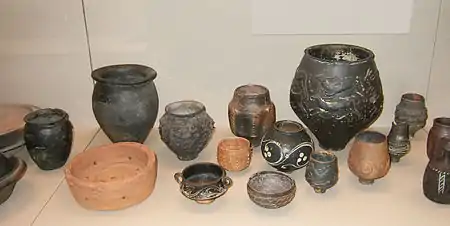Black-burnished ware
Black-burnished ware is a type of Romano-British ceramic. Burnishing is a pottery treatment in which the surface of the pot is polished, using a hard smooth surface. The classification includes two entirely different pottery types which share many stylistic characteristics. Black burnished ware 1 (BB1), is a black, coarse and gritty fabric. Vessels are hand made. Black burnished ware 2 (BB2) is a finer, grey-coloured, wheel thrown fabric.

Decoration on both types includes burnished lattice or, additionally, in the case of bowls and dishes, a wavy line design. Standard forms across both types include jars with everted rims and bowls with upright or flat flanged rims.
Black Burnished Ware 1
Black Burnished Ware Category 1 (BB1) is made from a clay body that has a coarse texture. The clay body can contain black iron ores, flint, quartz, red iron ores, shale fragments, and white mica.[1] BB1 can be grainy and black or dark gray in appearance. These wares are formed by hand.
BB1 wares were manufactured in the Dorset area and distributed throughout Britain.[2] The distribution of BB1 wares dates primarily to the mid-second to fourth centuries AD. Forms include bowls, dishes, and jars.[1]
Early BB1 influenced Vectis ware.[3]
Black Burnished Ware 2
Black Burnished Ware Category 2 (BB2) is greyer in color and has a finer texture when compared with BB1.[4] It is a “hard, sandy fabric, varying in colour from dark-grey or black with a brown or reddish brown core and a reddish-brown, blue-grey, black or lighter ('pearly grey') surface.”[5] The clay body can contain black iron ore, mica, and quartz, all in a matrix of sediment.[5] These wares are thrown on a fast potter's wheel.
BB2 wares were manufactured on both the Essex and Kent sides of the Thames Estuary.[6][7][8] The distribution of BB2 wares occurred from AD 140 through to the mid third century AD in south-east England and the northern part of Britain.[5]
References
- Tyers, P A. "South-east Dorset black-burnished 1." Potsherd. Accessed February 21, 2011. Last modified December 28, 2010. http://potsherd.net/.
- Allen, J. R. L.; Fulford, M. G. (1996). "The Distribution of South-East Dorset Black Burnished Category I Pottery in South-West Britain". Britannia. 27: 223–281. doi:10.2307/527045. JSTOR 527045. S2CID 162584757.
- Timby, Jane (2013). "Material Culture: pottery and fired clay". In Cunliffe, Barry (ed.). The Roman Villa at Brading, Isle of Wight: The Excavations of 2008-10. Oxford School or Archaeology. p. 192. ISBN 9781905905263.
- Darvill, T. (2003). Concise Oxford Dictionary of Archaeology. ISBN 9780192800053.
- Tyers, P A. "Black-burnished 2." Potsherd. Accessed February 21, 2011. Last modified December 28, 2010. http://potsherd.net/.
- Catherall, P. D.; Pollard, R. J.; Turner, R. C.; Monk, M. A. (1983). "A Romano-British Pottery Manufacturing Site at Oakleigh Farm, Higham, Kent". Britannia. 14: 103–141. doi:10.2307/526344. JSTOR 526344. S2CID 165766913.
- Monaghan, Jason (1987). Upchurch and Thameside Roman Pottery. Oxford: British Archaeological Reports British Series 173.
- Symonds, R. P.; Wade, Sue (1999). Roman Pottery from Excavations in Colchester, 1971-86. Colchester Archaeological Trust. ISBN 978-1-897719-07-7.